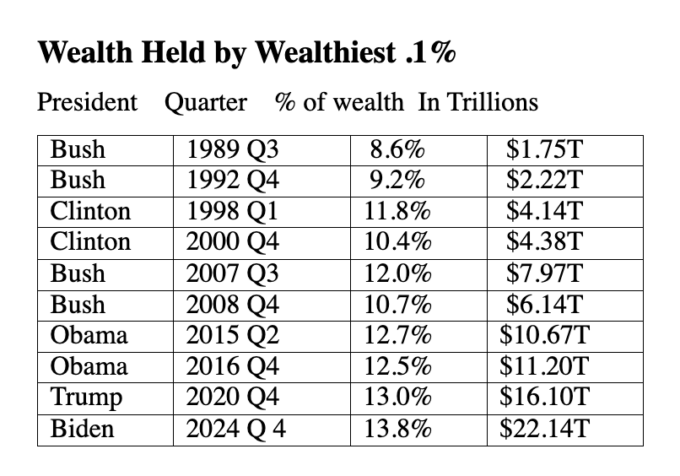Image by Morgan Housel.
The ability of the wealthy to accumulate more wealth has its ups and downs. However, as shown by the Federal Reserve Board’s (the Fed) Distribution of Household Wealth in the U.S. since 1989, the overall trend has been one in which the wealthiest .1% have succeeded at growing their share of the nation’s wealth. According to the Fed figures, by the end of the Biden presidency, the .1%’s share of the nation’s wealth reached 13.8%, increasing by over 60% from 8.6% in the third quarter of 1989 when daddy Bush was in power which is when the Fed figures cited start.
In fact, under each president since 1989, at some point during their term, the share of the nation’s wealth held by the wealthiest .1% reached new heights. Setbacks would follow, but in later years, a new all-time high would be reached. For example, during Junior Bush’s presidency, the Great Recession resulted in a large drop in the .1%’s share of the nation’s wealth. Despite the drop, at the end of Bush’s regime, their share was higher than it was at the end of Clinton’s time in office. During Obama’s and Trump’s presidencies, the share of the .1% became even larger. Biden’s tenure ended with their share reaching its highest point yet.
Many have difficulties protecting the current value of their assets and preventing them from being eroded by inflation. What is “impressive” is that not only have the wealthy .1% been successful at increasing their share of the nation’s wealth, but its total has far outstripped inflation, increasing in nominal dollars more than 121/2 times from 1989 to the end of 2024 from $1.75 trillion to $22.14 trillion while the total nominal wealth of the nation as a whole grew less than 8 times from $20.43 trillion to $160.35 trillion. During this same period, the poorest 50% of the population, almost exclusively members of the working class, saw their nominal wealth increase from $.71 trillion to $4.01 trillion, less than a sixfold increase. Unlike the super wealthy, much of their wealth is tied up in basic necessities such as a place to live.
Below is a table based on the Fed figures showing the high point during one’s presidency and the level of the wealth of the .1% at the end of the fourth quarter of the year right before each new president was sworn in (which may be the same as the high point), and the amount in trillions of dollars.

Many have longed for the days of bipartisanship, lamenting the polarization in our political system. However, what is striking about the Fed’s numbers, whether intentional or not, is the degree of bipartisanship around the .1% capturing a bigger share of the nation’s wealth. People often see Republicans as championing the interests of the wealthy, but the greatest recent increases in the share of the .1%’s wealth occurred during Democratic administrations.
From right before the start of the Clinton administration to its high point, the share of the wealth of the .1% during his time in office increased by 2.6% before declining to a gain of 1.4%. For Obama, it went up 2% after the decline from the Great Recession, and for Biden by .8%. By contrast, in the period covered starting in the third quarter of 1989, under daddy Bush, the increase was .6%. Under the second Bush, it increased 1.6% before tumbling during the Great Recession but still ending higher by .3% than it was at the end of the Clinton administration. The increase in the share of the .1% at the end of Trump’s first regime was .5% despite the pandemic.
Certainly, the increase in the wealth of the .1% during any administration may have much to do with changes in the capitalist economy beyond their control and the policies put in place by their predecessor (that are not reversed) and whose full impact is often realized in the subsequent administration. Bush 2 and Trump oversaw major tax cuts for the wealthy. However, Republican policies have not been alone in helping the .1% better their conditions. Under Clinton, there were tax cuts, much deregulation, and the repeal of sections of the Glass-Steagall Act, and Obama instituted the bailout of the financial industry.
Inequality Among the .1% and the 2025 Losses of U.S. Centibillionaires
Assuming the U.S. population was 340 million at the end of 2024, then the average holding of the wealthiest .1% or 340,000 people came to over $65 million. That is a large amount of money, but $65 million is less than .065% of $100 billion, an amount of wealth, according to the April 4, 2025 Bloomberg Billionaires Index, exceeded by 12 U.S. citizens. In other words, it could be viewed as minute when compared to the wealth of our multicentibillionaires, that as of April 3, according to the Bloomberg Index, included Musk, Bezos, and Zuckerberg, but as of April 4 had one lone member, Elon Musk, as can be seen in the table below.
As a group, these 12 U.S. centibillionaires are experiencing another one of those downturn periods. Using Bloomberg figures, since the beginning of the year, of the wealthiest 12, only Buffet has experienced an increase in the size of his fortune. The remaining 11 have, together for the year as of April 4, lost $359 billion led by Musk, who remains the world’s wealthiest individual despite experiencing a decline in his wealth of $130 billion so far this year, (or $147 billion since January 17, the day Trump was sworn in).[1] Has he been willing to tolerate this huge “sacrifice” because he sees his actions of “disrupting” many peoples’ lives as paving the way for greater gains to make up for his “suffering” from these great losses? Does he deserve to be “admired?” How many people have had the experience, while working in the government, of seeing the value of their wealth drop $130 billion in a short period of time and still remain the world’s wealthiest guy?
Below is a table based on Bloomberg Billionaires Index figures showing what has been happening to the wealth of U.S. centibillionaires.

Don’t shed any tears for the losses these poor folks have suffered. From 2021 to the end of 2024, their nominal wealth increased 82% or by $981.6 billion, far outstripping the rate of gain of the entire .1% during this period that grew 38%, less than half as much. As of April 4, the centibillionares are still up $626 billion from where their nominal wealth stood at the beginning of 2021.
With his fight for tax cuts for the wealthy and other favorable policies for them, despite the recent setbacks, Trump is likely to try to continue the trend of his recent predecessors of providing the .1% with a larger share of the nation’s wealth as he makes America great again while also accelerating the destruction of the environment, enhancing militarism and the threat of a nuclear catastrophe, and fomenting greater alienation and racism along with numerous other social ills.
Notes
1. Since the day Trump was sworn in, as of April 4, despite donating $1 million for Trump’s inauguration, Bezos wealth is down $52 billion, and Zuckerberg’s is down $38 billion. Could Trump be ushering in a revolt by the wealthy against his policies?
© Counter Punch


